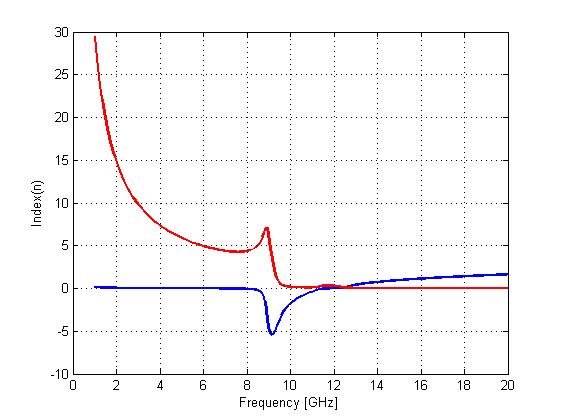Does anyone have any experience in the parameters retrival of metamaterials
I simulated SRR+wire in HFSS and get the same amplitude of S11 and S21, but the phase of thoses are different as shown in 'Electromagnetic parameter retrieval from inhomogeneous metamaterials' by D.R.Smith. Can anyone tell me what is the problem?
By the way, if I want to retrieve the permittivity and permibility from SRR and wire, which method is prefered currently? I heard that the method proposed by D.R.Smith, etc, is only able to handle the problem when the slab is thin.
Many thanks for your attention and answers.
Maybe, HFSS is calculating S11 and S21 according to where the ports are. But in that paper, they can calculate S11 and S21 at material boundries, thus you have to carry the ports to the material boundries.
thanks very much for your answer.
I found that the phase should be adjust to overcome the discontinuity. it is easy to observed that the phase will meet a flip at some band. in this situation, we shoud add or delete 2*pi to make it continue.
Quick definition first:
S11A = Amplitude of S11
S11P = Phase of S11
S11 is typical represented by S11A*exp( j * S11p)
Smith et al. uses S11A*exp(- j * S11p)
I have not seen a different way to extract material parameters from s-parameters other than this method.
FYI - there has a been a lot of people who have tried to replicate that paper. I do not know of many people who have successfully done so. Let me know how it goes.
yes, i successfully replicated this paper. the s-parameter S11 should be adjusted. I did it this way:
export S11_mag,S21_mag and S11_rad, S21_rad.
adjust S21_rad when discontinuous happenes. it should be added by -2*pi.
then extract the electromagnetic parameters.
I am now trying to apply this to terahertz regime to see what happens.
In order to take care of the discontinuites in the phase plot for S-parameters, one of doing is to export and add -2*pi as suggested by fangjing.
Actually, there is no need to do that if you are using HFSS.
HFSS has an built in function. You can select cang_rad() instead of ang_rad(). It does it automatically.
cang_rad() stands for cumulative angle and it takes care of the phase discontinuites.
Even I tried to replicate the S-parameter retrieval from the paper from Smith. I got the following responses. I got exactly the same plot for magnitude plot. And even phase plot using cang_rad() , but it was inverted. What I mean is, when I created a output variable with -cang_rad(). I got exactly the same phase plot that is given in the paper.And I attached the images.
MY QUESTION IS: Is there any reason for taking negative of the phase plot or am I missing anything.
fangjing: Were you able to replicate the graphs of mu, epsilon, and the refractive index?
---------- Post added at 04:33 ---------- Previous post was at 04:28 ----------
If you look at what i posted it explains it. A forward propagating wave can be model as + j or -j. It all depends on how you want to describe it. As long as you stick to your convention you will be fine.
i think so.
see the attachment
but i don't know if it works when the slab is thin.



Does anyone try to obtain the same results in CST ?
yes, i have tried what you mentioned, it really works! I have extracted the epsilon and mu0 successfully
Thanks very much!
---------- Post added at 10:18 ---------- Previous post was at 10:16 ----------
sorry, i didn't have any experience in CST simulation.
maybe i will try later. i will post if anything is obtained.
Hi fangjing, how did you plot the refractive index(n) and the remaining plots? I mean which expression did you use?
i did as the paper by D.R.Smith, Electromagnetic parameter retrieval from inhomogeneous metamaterials, equation (9) and (10)
Hai fangjing, in equation(9) for calculating the refractive index, for kd =(2pi/lamda)*d; d =2.5mm.
Did you calculate the guided wavelength at 9GHz ? Or did you approximate that kd is equal to 1.
index=-1i.*log(eink0d)./k_0./cell_thickness;
hi fangjing, can you upload your code for retrieval of parameters. i think that can help a lot to get idea about reproducing the results
hi got the result for s11 and s21 amplitude same as the paper . the problem is that i can found a resonance in amplitude but not in phase. phase is very much continuoous . can anyone say whats the problem? so my retrieved parameter like the real part of index go several times in negative value though there is only one lc resonance and one plasmonic resonance in the transmission characteristics
I almost extracted the refractive index. I used equation (9) from the D.R.Simth's paper "Electromagnetic parameter retrieval from inhomgeneous metamaterials"
k = wavenumber (= ω/c) and d = 2.5mm.
I got exactly the same Imaginary Refractive Index. See the attached image:
I was not able to figure out why the real refractive index got messed up after 10 GHz (circled part in image)
Any help in this regard is appreciated.

srr2.bmpsrr3.bmpsrr1.bmpsrr3.bmpsrr2.bmpHello, I am using CST at the moment and I have tried to obtain the same results as the Smith's paper.
This is what I have managed to find. You will notice a small difference in the magnitude of S where I find the resonance a little bit different than the Smith's paper and I also find the phase of S in degrees not radiants (which ofcourse can easily be done in Matlab).
My question is why this little difference in the resonanance in S11? Does anyone have a clue?
Thanks!
p.s. I attached the results that I have found!
Attachment 51226
i do not getting enough resonance in phase while i am getting resonance in amplitude. is that due to any fault in design. pz help in this regards
